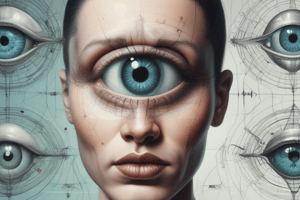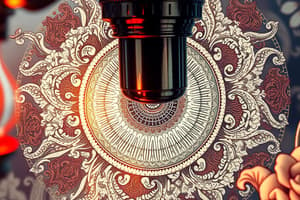Podcast
Questions and Answers
What is the main goal of retinoscopy?
What is the main goal of retinoscopy?
- Evaluate the peripheral vision of the patient
- Determine the distance refractive status of the patient’s eyes (correct)
- Measure the patient's intraocular pressure
- Locate the near point of the spherical eye
Which retinoscopy method allows for more accurate cylinder axis and power determination?
Which retinoscopy method allows for more accurate cylinder axis and power determination?
- Spot retinoscopy
- Streak retinoscopy (correct)
- Photorefractor
- Automated refractor
What is the purpose of bringing the patient’s far point to a predetermined distance during retinoscopy?
What is the purpose of bringing the patient’s far point to a predetermined distance during retinoscopy?
- To facilitate subjective refraction (correct)
- To determine the retinal condition
- To measure intraocular pressure
- To enhance peripheral vision
Which retinoscope type is known for being more accurate and fast?
Which retinoscope type is known for being more accurate and fast?
What distinguishes a Streak retinoscope from a Spot retinoscope?
What distinguishes a Streak retinoscope from a Spot retinoscope?
Which part of the retinoscope is responsible for controlling the brightness of the reflex?
Which part of the retinoscope is responsible for controlling the brightness of the reflex?
What is the primary function of the battery handle in a retinoscope?
What is the primary function of the battery handle in a retinoscope?
Which type of retinoscopy requires external light source and is very fast for estimation?
Which type of retinoscopy requires external light source and is very fast for estimation?
What is the purpose of using trial lenses and a trial frame in the eye examination process?
What is the purpose of using trial lenses and a trial frame in the eye examination process?
At what range can the refractor or phoropter typically adjust for sphere lenses?
At what range can the refractor or phoropter typically adjust for sphere lenses?
What type of lenses are used in Mohindra's Set Up for retinoscopy screenings?
What type of lenses are used in Mohindra's Set Up for retinoscopy screenings?
What is used to determine refractive error without the input of the patient in an eye examination?
What is used to determine refractive error without the input of the patient in an eye examination?
Which instrument is best suited for checking astigmatic axis and power in an eye examination?
Which instrument is best suited for checking astigmatic axis and power in an eye examination?
What is the main reason for using a Retinoscope light with an intensity enough to observe the reflex but still keep the patient comfortable?
What is the main reason for using a Retinoscope light with an intensity enough to observe the reflex but still keep the patient comfortable?
What is the primary purpose of using prisms during an eye examination?
What is the primary purpose of using prisms during an eye examination?
Why are trial lenses and a trial frame particularly useful for examining children and bedridden patients?
Why are trial lenses and a trial frame particularly useful for examining children and bedridden patients?
What is the purpose of determining the power of the eyes in a refraction?
What is the purpose of determining the power of the eyes in a refraction?
What is one of the common sources of error in retinoscopy?
What is one of the common sources of error in retinoscopy?
Why is it important to measure interpupillary distance before ordering spectacle lenses?
Why is it important to measure interpupillary distance before ordering spectacle lenses?
In retinoscopy, what happens if the patient fails to fixate on the distance target?
In retinoscopy, what happens if the patient fails to fixate on the distance target?
What is the significance of obtaining reversal in retinoscopy?
What is the significance of obtaining reversal in retinoscopy?
Which instrument is commonly used to measure interpupillary distance?
Which instrument is commonly used to measure interpupillary distance?
What is one of the potential errors in retinoscopy related to working distance?
What is one of the potential errors in retinoscopy related to working distance?
How does looking at a patient during retinoscopy affect the procedure?
How does looking at a patient during retinoscopy affect the procedure?
What does a smooth “full moon” of red over the retina indicate in photorefraction paraxial photorefraction?
What does a smooth “full moon” of red over the retina indicate in photorefraction paraxial photorefraction?
In photorefraction paraxial photorefraction, what does a bright half moon over the top of the pupil indicate?
In photorefraction paraxial photorefraction, what does a bright half moon over the top of the pupil indicate?
What is indicated by a brighter crescent moon in the bottom half of the eye in photorefraction paraxial photorefraction?
What is indicated by a brighter crescent moon in the bottom half of the eye in photorefraction paraxial photorefraction?
When conducting myopia hyperopia photorefraction with 3 photos at different axial planes, what is determined by taking the 1st photo at 75cm?
When conducting myopia hyperopia photorefraction with 3 photos at different axial planes, what is determined by taking the 1st photo at 75cm?
During myopia hyperopia photorefraction, if the pupil is larger at 150cm, what type of eye condition is indicated?
During myopia hyperopia photorefraction, if the pupil is larger at 150cm, what type of eye condition is indicated?
In photorefraction paraxial photorefraction, why are the 2nd and 3rd photos taken at different axial planes and compared?
In photorefraction paraxial photorefraction, why are the 2nd and 3rd photos taken at different axial planes and compared?
Which action during myopia hyperopia photorefraction helps differentiate between myopia and hyperopia?
Which action during myopia hyperopia photorefraction helps differentiate between myopia and hyperopia?
What are the most common monochromatic optical aberrations encountered in Keratoconus and PMD?
What are the most common monochromatic optical aberrations encountered in Keratoconus and PMD?
In which part of the pupil does neutrality reach first when performing retinoscopy in Keratoconus and PMD?
In which part of the pupil does neutrality reach first when performing retinoscopy in Keratoconus and PMD?
What happens to the refraction of the eye when the pupil dilates in individuals with Keratoconus and PMD?
What happens to the refraction of the eye when the pupil dilates in individuals with Keratoconus and PMD?
When confused reflexes are encountered during retinoscopy, what is the recommended approach in Keratoconus and PMD?
When confused reflexes are encountered during retinoscopy, what is the recommended approach in Keratoconus and PMD?
Which group is more likely to experience 'False Neutrality' in retinoscopy in Keratoconus and PMD?
Which group is more likely to experience 'False Neutrality' in retinoscopy in Keratoconus and PMD?
What is the characteristic motion observed during retinoscopy in Keratoconus and PMD?
What is the characteristic motion observed during retinoscopy in Keratoconus and PMD?
In which part of the pupil does the retinoscopy reflex move more quickly as neutrality is approached in Keratoconus and PMD?
In which part of the pupil does the retinoscopy reflex move more quickly as neutrality is approached in Keratoconus and PMD?
Flashcards are hidden until you start studying




